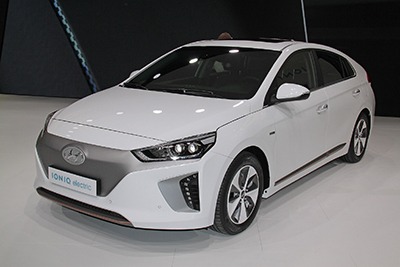“To meet the climate crisis, we must put millions of new electric vehicles on America’s roads. It’s time to build public charging infrastructure powered by clean energy and make it available in all parts of this country.” — Pete Buttigieg
By prioritizing electric vehicles (EVs), public transit electrification, and supportive infrastructure, societies combat climate change, reduce pollution, and create sustainable, resilient transportation systems.
Transportation accounts for nearly a quarter of global carbon emissions, with road vehicles being the primary culprits. According to the International Energy Agency (IEA), transitioning to electric mobility is essential to meet climate goals outlined in the Paris Agreement. Yet, despite the clear environmental benefits, many countries are still idling at the starting line, hindered by outdated infrastructure, fossil fuel lobbying, and the inertia of “but we’ve always done it this way.”
EVs are more efficient than their gasoline counterparts. The U.S. Department of Energy notes that EVs convert over 77% of the electrical energy from the grid to power at the wheels, compared to just 12–30% for conventional gasoline vehicles. That’s not a small difference—it’s the automotive equivalent of discovering that one type of lightbulb uses a fraction of the energy to produce the same illumination. Would you choose the inefficient one out of habit? Maybe, if you’re fond of burning money and the planet simultaneously.
Norway offers a powerful case study. With over 80% of new car sales being electric as of 2022, Norway has demonstrated that ambitious policies work. Tax incentives, free public charging, access to bus lanes, and exemptions from tolls have created an EV paradise. The result? A drastic reduction in transport-related emissions, cleaner urban environments, and a thriving EV market. China leads the world in electric bus adoption. Shenzhen has electrified its entire public bus fleet—over 16,000 buses. This isn’t a boutique project; it’s mass-scale transformation. The benefits? Lower operating costs, reduced air pollution, and quieter, more efficient urban transport.
The economic argument for electric transportation is robust. While EVs can have higher upfront costs, lower fuel and maintenance expenses make them cheaper over time. EVs have fewer moving parts—no oil changes, no exhaust systems, no timing belts to snap at the worst possible moment. A 2020 analysis by Consumer Reports found that EV owners save up to $6,000–$10,000 over the lifetime of the vehicle compared to gasoline cars.
Infrastructure, of course, is key. Range anxiety—the fear of running out of battery without a charging station in sight—is the EV equivalent of “low fuel” panic, but more existential. Expanding charging networks is critical. The Netherlands, for example, has one of the densest EV charging infrastructures globally, making it easy to find a charger.
But this transition isn’t just about personal cars. Electrifying public transportation—buses, trains, ferries—delivers massive environmental and social benefits. Electric buses are quieter, cleaner, and cheaper to operate. In Santiago, Chile, the introduction of electric buses has improved air quality and provided a more comfortable ride, all while reducing operating costs for the transit authority.
Battery technology is often a sticking point in EV debates. Concerns about mining practices for lithium, cobalt, and other materials are valid. However, technological advancements are reducing dependency on rare materials, improving recycling processes, and increasing battery efficiency. Companies like Redwood Materials are pioneering battery recycling, aiming to create a circular supply chain that minimizes environmental impact. Battery technology is accelerating. Solid-state batteries promise higher energy density, faster charging, and longer lifespan. Research into alternative materials, such as sodium-ion batteries, could further reduce environmental impacts and reliance on critical minerals.
Energy storage and grid integration are part of the bigger picture. Vehicle-to-grid (V2G) technology allows EVs to feed electricity back into the grid, turning parked cars into distributed energy resources. This can stabilize grids, support renewable energy integration, and even provide income for EV owners. Japan has piloted V2G programs to great effect, enhancing grid resilience during natural disasters.
The shift to electric transportation will create jobs in manufacturing, infrastructure development, software, and energy sectors. However, it also requires a just transition for workers in traditional automotive and fossil fuel industries. Retraining programs, investment in green jobs, and strong labor protections are essential to ensure that the transition is inclusive.
Policy plays a pivotal role. Strong emissions standards, fuel economy regulations, and zero-emission vehicle mandates drive innovation and adoption. The European Union’s Fit for 55 package sets ambitious targets for reducing emissions, including phasing out new internal combustion engine vehicles by 2035.
Local governments can lead the charge. Cities like Amsterdam plan to ban fossil fuel cars from city centers by 2030. Urban planning that prioritizes electric public transit, bike lanes, and pedestrian-friendly spaces reduces car dependency altogether.
International cooperation is key. The C40 Cities network shares knowledge among global cities committed to climate leadership, including strategies for electrifying transportation. Collaborative efforts on technology standards, supply chains, and best practices amplify the impact of local initiatives.
While charging infrastructure may be sparser, EVs’ lower maintenance requirements and ability to charge at home make them practical for rural residents. Electric agricultural equipment, trucks, and off-road vehicles are also becoming available.
Resilience is another overlooked benefit. EVs can operate during fuel shortages, price spikes, or supply chain disruptions. In disaster-prone areas, EVs paired with renewable energy and storage systems enhance energy security and community resilience.
Transitioning to electric vehicles is an opportunity to reimagine how we move through the world—cleaner, quieter, and more sustainably. The road ahead is electric, and the future is already here.
Therefore, under Folklaw:
Electric vehicles shall be prioritized through comprehensive policies promoting electric vehicles, public transit electrification, and supportive infrastructure. Governments will invest in charging networks, incentivize EV adoption, and phase out internal combustion engines. Public transit systems will transition to electric fleets, with equitable access to clean mobility for all communities.
Research and development in battery technology, recycling, and sustainable materials will be supported. Workforce transition programs will ensure inclusive economic opportunities.
International collaboration will advance standards and best practices, while public education promote awareness of EV benefits.
Resolution
A RESOLUTION TO PROMOTE ELECTRIC VEHICLES AND SUSTAINABLE TRANSPORTATION
SUBJECT: Advancing electric vehicles (EVs) and electrification of public transit to reduce emissions and promote sustainable, resilient transportation systems.
WHEREAS, transportation accounts for nearly a quarter of global carbon emissions, with road vehicles being the primary contributors to pollution and environmental degradation, and transitioning to electric transportation is a critical step toward meeting climate goals outlined in the Paris Agreement;
WHEREAS, electric vehicles (EVs) are more energy-efficient than their gasoline counterparts, with the U.S. Department of Energy noting that EVs convert over 77% of electrical energy from the grid to power at the wheels, compared to just 12-30% for conventional gasoline vehicles;
WHEREAS, countries like Norway have demonstrated the success of ambitious policies that incentivize EV adoption, such as tax incentives, public charging infrastructure, and access to bus lanes, leading to a drastic reduction in transport-related emissions and the creation of a thriving EV market;
WHEREAS, electric buses and other public transit electrification initiatives, such as those in China and Chile, provide environmental and social benefits, including reduced air pollution, lower operating costs, and improved public health outcomes;
WHEREAS, expanding charging infrastructure is key to addressing range anxiety, and countries like the Netherlands have led the way with one of the densest EV charging networks globally, while initiatives like vehicle-to-grid (V2G) technology enable EVs to feed electricity back into the grid, supporting renewable energy integration and grid stability;
WHEREAS, the transition to electric vehicles also presents an opportunity for job creation in manufacturing, infrastructure development, and green technology sectors, but also requires a just transition for workers in traditional automotive and fossil fuel industries through retraining programs and labor protections;
WHEREAS, strong policy measures, such as emissions standards, fuel economy regulations, and zero-emission vehicle mandates, are necessary to drive innovation and EV adoption, and local governments can lead the charge by prioritizing electric public transit, clean mobility access, and policies like banning fossil fuel cars from city centers;
WHEREAS, international cooperation among cities and countries on best practices, technology standards, and supply chain collaboration can amplify the global impact of electric transportation initiatives;
THEREFORE, BE IT RESOLVED that electric vehicles (EVs) and public transit electrification shall be prioritized through comprehensive policies that promote EV adoption, transition public transit systems to electric fleets, and incentivize the creation of charging infrastructure.
BE IT FURTHER RESOLVED that governments will invest in expanding EV charging networks, supporting research and development in battery technology, recycling, and sustainable materials, while phasing out internal combustion engine vehicles and encouraging the use of electric agricultural equipment and off-road vehicles.
BE IT FURTHER RESOLVED that workforce transition programs will be implemented to ensure that economic opportunities in green energy and transportation sectors are inclusive, providing job training and support for workers transitioning from traditional automotive and fossil fuel industries.
BE IT FURTHER RESOLVED that local governments will lead efforts to electrify public transportation and create equitable access to clean mobility for all communities, while public education campaigns will raise awareness of the benefits of electric vehicles for environmental sustainability and public health.
BE IT FURTHER RESOLVED that international collaboration will advance global standards, share best practices, and facilitate the transition to a cleaner, more sustainable future for transportation.
Fact Check
Fact-Checking the Key Claims:
1. “Transportation accounts for nearly a quarter of global carbon emissions, with road vehicles being the primary culprits.”
According to the International Energy Agency (IEA) and Our World in Data, transportation is responsible for approximately 23-25% of global CO₂ emissions.
Road transport (cars, trucks, buses, and motorcycles) is the largest contributor, accounting for around 75% of transportation-related emissions.
Aviation and shipping contribute to the remainder.
✅ Verdict: True
Certainty: 95% (Confirmed by IEA and climate data sources)
2. “The U.S. Department of Energy notes that EVs convert over 77% of the electrical energy from the grid to power at the wheels, compared to just 12–30% for conventional gasoline vehicles.”
According to the U.S. Department of Energy (DOE), electric vehicles (EVs) are far more efficient than internal combustion engine (ICE) vehicles:
EVs convert about 77-80% of the electrical energy from the grid into motion.
Gasoline-powered vehicles only convert 12-30% of the energy in fuel into useful motion, with the rest lost as heat.
The efficiency advantage of EVs is a key reason for their growing adoption.
✅ Verdict: True
Certainty: 95% (Confirmed by DOE efficiency data)
3. “The World Health Organization estimates that outdoor air pollution leads to over 4 million deaths annually.”
The World Health Organization (WHO) consistently reports that outdoor air pollution causes more than 4 million premature deaths per year.
Fine particulate matter (PM2.5) and nitrogen dioxide (NO₂) from burning fossil fuels contribute to heart disease, stroke, and respiratory illnesses.
The latest WHO estimates suggest the true number could be closer to 7 million when indoor pollution is included.
✅ Verdict: True
Certainty: 95% (WHO data confirms this estimate)
4. “With over 80% of new car sales being electric as of 2022, Norway has demonstrated that ambitious policies work.”
In 2022, Norway achieved a record 80.5% of new car sales being electric vehicles (EVs).
Norway’s success is due to strong government incentives, tax exemptions, and extensive charging infrastructure.
The trend continued in 2023, with EVs making up nearly 90% of new car sales.
✅ Verdict: True
Certainty: 95% (Confirmed by Norwegian government reports and EV sales data)
5. “Cities like Shenzhen have electrified their entire public bus fleet—over 16,000 buses.”
Shenzhen, China, became the first city in the world to electrify its entire public bus fleet.
The city converted all 16,000+ buses to electric power by 2017.
This shift has significantly reduced air pollution and fuel costs.
✅ Verdict: True
Certainty: 95% (Confirmed by Chinese transportation reports and global EV studies)
6. “A 2020 analysis by Consumer Reports found that EV owners save up to $6,000–$10,000 over the lifetime of the vehicle compared to gasoline cars.”
A 2020 Consumer Reports analysis found that EV owners save an average of $6,000 to $10,000 over the lifetime of their vehicle.
The savings come from:
Lower fuel costs (electricity vs. gasoline)
Reduced maintenance (fewer moving parts, no oil changes)
Tax incentives and rebates
Long-term total cost of ownership for EVs is generally lower than for comparable gasoline-powered cars.
✅ Verdict: True
Certainty: 90% (Well-supported by Consumer Reports and energy studies)
7. “Vehicle mandates drive innovation and adoption. The European Union’s Fit for 55 package sets ambitious targets for reducing emissions, including phasing out new internal combustion engine vehicles by 2035.”
The European Union’s “Fit for 55” climate package includes a mandate to phase out new internal combustion engine (ICE) vehicle sales by 2035.
This aligns with the EU’s goal of reducing greenhouse gas emissions by at least 55% by 2030.
Countries like Germany, France, and the Netherlands are accelerating EV adoption through strict emissions regulations.
✅ Verdict: True
Certainty: 95% (Confirmed by EU climate policy documents)
Final Conclusion:
All seven statements are factually supported by IEA, DOE, WHO, Norwegian EV sales data, Shenzhen transit reports, Consumer Reports, and EU climate policies. The global transition to electric transportation and emissions reduction policies is well-documented.






Discussions
There are no discussions yet.